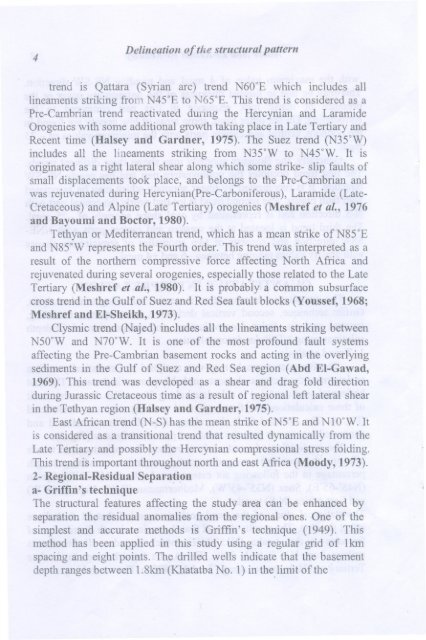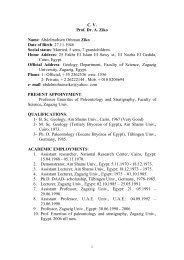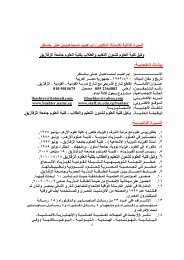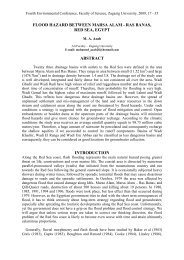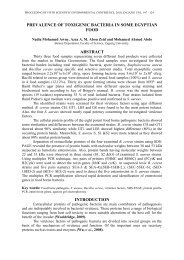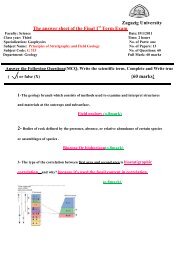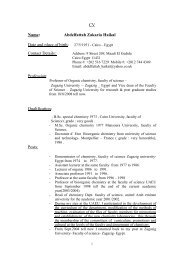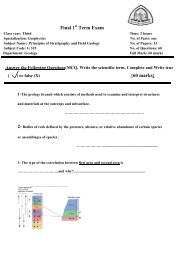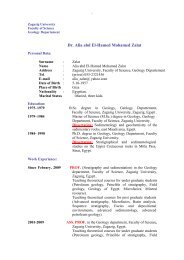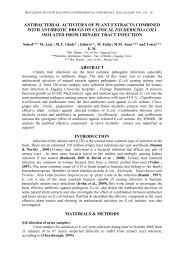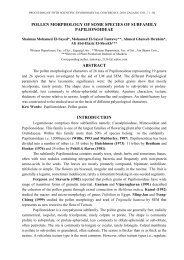GEOPHYSICS LETTERS
GEOPHYSICS LETTERS
GEOPHYSICS LETTERS
- No tags were found...
Create successful ePaper yourself
Turn your PDF publications into a flip-book with our unique Google optimized e-Paper software.
4Delineation of the structural patterntrencf is Qattara (Syrian arc) trend N600E which includes alllineaments striking from N45°E to N65°E. This trend is considered as aPre-Cambrian trend reactivated dunng the Hercynian and LaramideOrogenies with some additional growth taking place in Late Tertiary andRecent time (Halsey and Gardner, 1975). The Suez trend (N35°W)includes all the lineaments striking from N35°W to N45"W. It isoriginated as a right lateral shear along which some strike- slip faults ofsmall displacements took place, and belongs to the Pre-Cambrian andwas rejuvenated during Hercynian(Pre-Carboniferous), Laramide (Late-Cretaceous) and Alpine (Late Tertiary) orogenies (Meshref et al., 1976and Bayoumi and Boctor, 1980).Tethyan or Mediterranean trend, which has a mean strike ofN85°Eand N85°W represents the Fourth order. This trend was interpreted as aresult of the northern compressive force affecting North Africa andrejuvenated during several orogenies, especially those related to the LateTertiary (Meshref et al., 1980). It is probably a common subsurfacecross trend in the Gulf of Suez and Red Sea fault blocks (Youssef, 1968;Meshref and El-Sheikh, 1973).Clysmic trend (Najed) includes all the lineaments striking betweenN500W and N70oW. It is one of the most profound fault systemsaffecting the Pre-Cambrian basement rocks and acting in the overlyingsediments in the Gulf of Suez and Red Sea region (Abd EI-Gawad,1969). This trend was developed as a shear and drag fold directionduring Jurassic Cretaceous time as a result of regional left lateral shearin the Tethyan region (Halsey and Gardner, 1975).East African trend (N-S) has the mean strike ofN5°E and NIOOW.Itis considered as a transitional trend that resulted dynamically from theLate Tertiary and possibly the Hercynian compressional stress folding.This trend is important throughout north and east Africa (Moody, 1973).2- Regional-Residual Separationa- Griffin's techniqueThe structural features affecting the study area can be enhanced byseparation the residual anomalies from the regional ones. One of thesimplest and accurate methods is Griffin's technique (1949). Thismethod has been applied in this' study using a regular grid of lkmspacing and eight points. The drilled wells indicate that the basementdepth ranges between 1.8km (Khatatba No. 1) in the,limit of the .'


